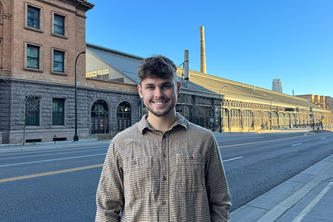New U of M study outlines recommendations for conserving state’s threatened groundwater supply

Nearly 75% of Minnesotans rely on groundwater for their water supply, but that supply can become strained as population grows, land-use changes, and climate change affects precipitation and groundwater use and recharge. These factors mean that many in the state could find groundwater in increasingly short supply in the coming decades— an issue some already face now.
In new research from the University of Minnesota Water Resources Center and Freshwater, scientists examined four aquifers across Minnesota to determine if aquifer storage and recovery (ASR) — which aims to treat, inject and temporarily store clean water in aquifers — may provide a solution to meet future demands of residents, industry and agriculture.
Researchers determined that three of the aquifers may be suitable for ASR. To make these determinations, a new GIS-based mapping tool created for this study used Minnesota's nascent aquifer properties database, as well as data reported in publications and unpublished government and consulting reports. The tool produced maps for three of the four study aquifers that show:
- the long-term, average groundwater level and depth-to-groundwater;
- aquifer-characteristics obtained from pump tests and specific capacity tests;
- available headspace in the aquifer where water can be safely injected for storage; and
- injection capacity of the aquifers
Based on these findings, the three aquifers found suitable for ASR are:
- Buffalo aquifer: Located near Moorhead, Minn., it is one of only a few aquifers available to the city. It is a narrow, sand-and-gravel aquifer that extends along much of the western part of Clay County. Alleviating flood pressure in the Red River valley was a secondary motivation for site selection.
- Southern Washington County aquifer: Centered near Woodbury, projected deficits in groundwater supply and groundwater pollution issues motivated this choice. ASR may play a role in the treatment of PFAS-contaminated groundwater in the area.
- Rochester aquifer: The Jordan Sandstone aquifer extends across much of southeastern Minnesota. Rochester is totally dependent on groundwater and has projected significant growth. Treated wastewater is a viable source.
The fourth aquifer, the Straight River aquifer was not evaluated for injection capacity due to the unavailability of sufficient water volume for injection. This aquifer is a surficial sand aquifer west of Park Rapids and is part of the larger Pineland Sands aquifer. The region receives rapid recharge of about five to six inches per year that discharges as base flow to the Straight River, a cold-water stream. Irrigated agriculture is reducing baseflow to the stream seasonally.
“We built the team that completed this first-of-its kind study for Minnesota,” said Carrie Jennings, adjunct assistant professor at the University and research and policy director at Freshwater. “During the project, cities and their consultants told us why they need this tool right away to address critical water supply needs.”
Among the research team’s final recommendations were that artificial recharge options should be considered and implemented where feasible and appropriate. ASR is a tool that may be useful in ensuring groundwater sustainability in some places with strict oversight, clear guidelines and a permitting path.
However, ASR should only remain a tool of last resort after other approaches to meet groundwater sustainability needs are exhausted. Lastly, Minnesota should continue to encourage conservation efforts whenever possible and eliminate any barriers to water reuse.
Peter Kang, an author on this study and assistant professor in the Department of Earth and Environmental Sciences of the College of Science and Engineering, is continuing portions of the research and application of the modeling developed to areas in the east metropolitan area of the Twin Cities for the future.
Funding for this project was provided by the Minnesota Environment and Natural Resources Trust Fund as recommended by the Legislative-Citizen Commission on Minnesota Resources (LCCMR) in 2018. Other funds came from grants from the Future Research Program funded by the Korea Institute of Science and Technology (KIST) and the Korea Research Fellowship program funded by the Ministry of Science and ICT through the National Research Foundation of Korea.
- Categories:
- Agriculture and Environment





